You just got to the grocery store, and they are all out of fresh basil. Now what? Fortunately, this post is all about the best substitutes for basil, starting with dried basil. Some leafy greens are merely an acceptable substitute, while others make for a great alternative to basil!
This post may contain affiliate links.
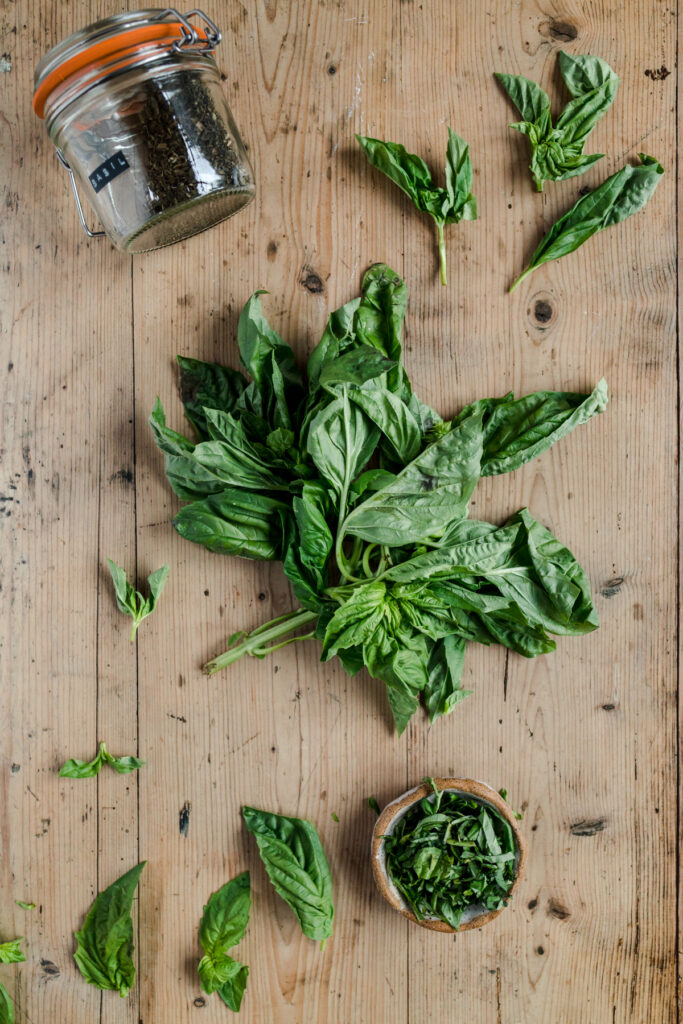
This list can help you decide what common herb to use in various dishes to get that unique taste you’re looking for. Whether you’re cooking Mediterranean cuisine, cooking up Italian recipes Thai dishes, or making a family favorite, there is an aromatic herb that will work. It’s also always nice to use a versatile herb to garnish your plate with a small amount of green color for those all-important presentation points.
5 Basil Facts
- The basil plant originates from tropical regions of Southeast Asia and Central Africa.
- It’s estimated that there are anywhere from 50 to 150 different varieties of basil, including holy basil, cinnamon basil, lime basil, Italian basil, lemon basil, and Thai basil. However, the leafy green you are probably most often familiar with is sweet basil.
- This popular herb is a member of the mint family. The flavor profiles of sweet basil offer a fresh, concentrated flavor to dishes with a slightly peppery flavor, anise, and mint taste.
- Basil is a core ingredient for traditional pesto.
- You may be familiar with green basil, but did you know you can also get purple basil?
Dried Vs. Fresh Basil
Always use fresh basil leaves as the taste is optimal. However, if it’s a key ingredient in your recipe, dried basil is the best basil alternative. It’s always good to have dried herbs on hand for moments when you want to emulate the flavor of the fresh herb. Then, you can always use another herb or leaf to add as garnish.
A good rule of thumb is to use a 3:1 ratio. Three parts fresh basil is roughly equivalent to one part dried basil.
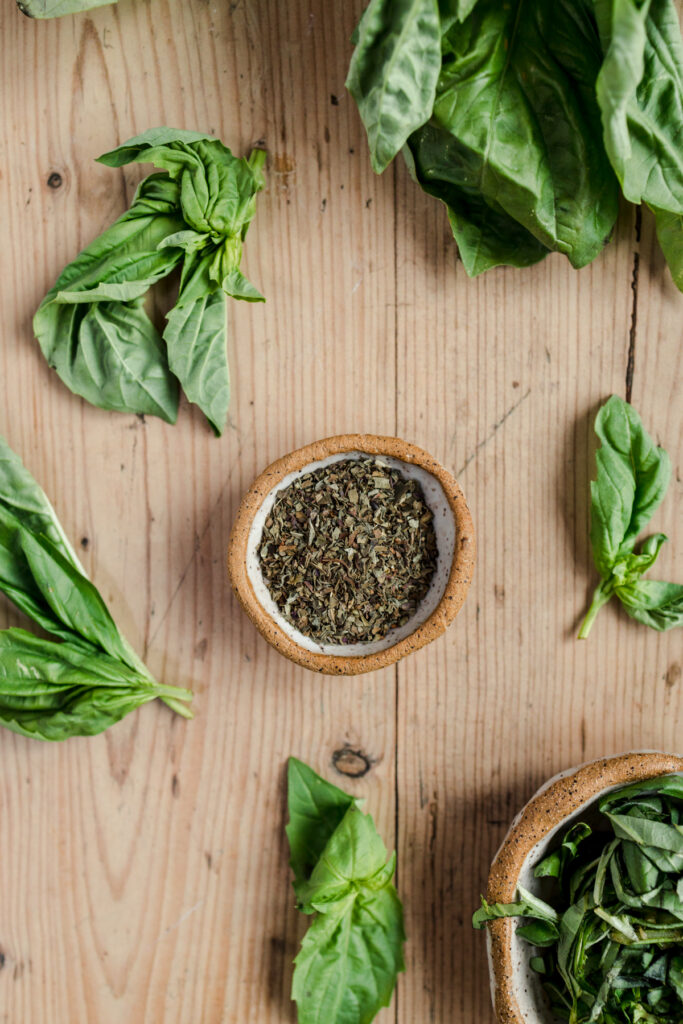
31 Best Substitutes for Basil
Are you set on a recipe that calls for basil, and then all your local grocery stores are out? Not to worry! Here are my top 31 basil substitutes.
Of course, no herb will be identical to basil in texture and taste, but these are the best ways to add a garnish or a herbal flavor to your dish when you are out of basil.
- Dried Basil: Dried Basil stands as a testament to the herb’s versatility and enduring flavor. When fresh basil is unavailable, its dried counterpart steps in, offering a more concentrated, slightly sweet, and subtly spicy flavor. It’s an indispensable pantry staple, especially useful in dishes that cook for longer periods, like stews and sauces, where it has the time to unfurl its rich aroma. Its longevity and ease of storage make it a reliable alternative for those moments when the fresh herb is out of reach.
- Thai Basil: Thai Basil is a distinct variety that sets itself apart with a robust, spicy flavor, marked by hints of licorice and clove. This type of basil is a staple in Southeast Asian cuisine, particularly in Thai dishes like curries, stir-fries, and soups. Its sturdy leaves hold up well to cooking, making it an excellent choice for dishes that require simmering, where it imparts a depth of complex and aromatic flavor.
- Purple Basil: Purple Basil, with its striking dark leaves, is a visual delight and a culinary treat. This variety offers a slightly milder flavor compared to its green counterparts, with a subtle peppery taste that works wonderfully in fresh salads and garnishes. Purple basil is also a great addition to infused oils and vinegar, where it lends its vibrant color and a hint of its delicate flavor, adding a unique twist to simple dishes.
- Holy Basil: Holy Basil, also known as Tulsi, is revered for its medicinal properties as well as its culinary use, especially in Indian cuisine. It has a sharp, peppery flavor with undertones of clove and mint, setting it apart from other varieties. In cooking, it’s often used in spicy stir-fries and herbal teas, where it contributes a warming, aromatic quality. Holy basil is not just a culinary herb but is also cherished for its health benefits, including stress relief and immune support.
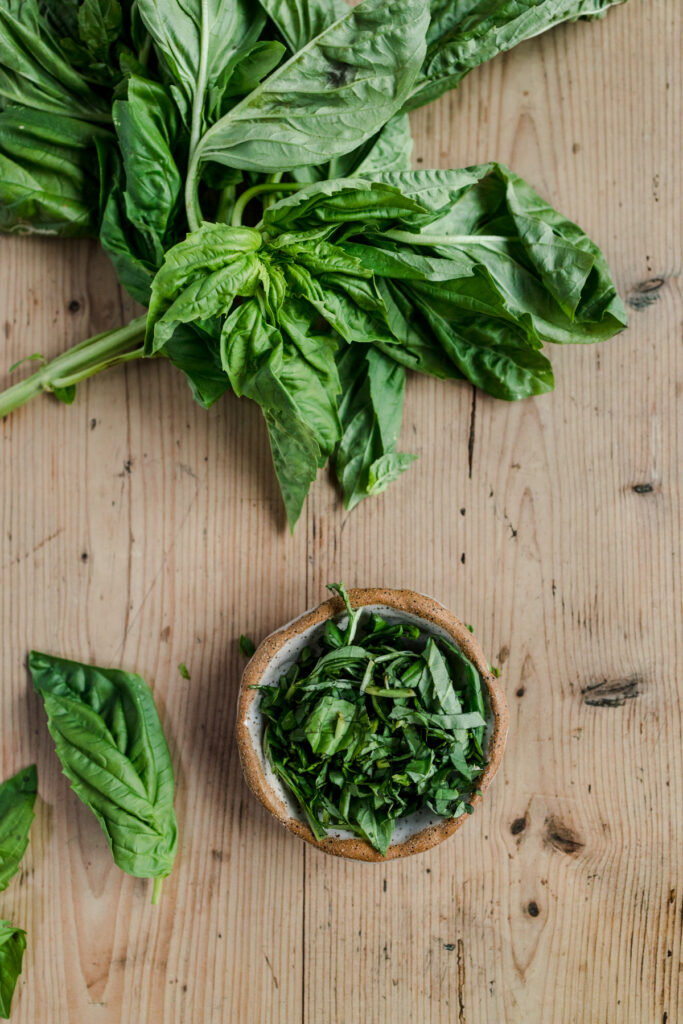
- Lemon Basil: Lemon Basil is a fragrant, citrus-scented variety of basil that brings a burst of freshness to any dish. As the name suggests, it has a strong lemon aroma, making it an excellent choice for adding a zesty note to salads, fish dishes, and even desserts. Its light and refreshing flavor makes it a favorite for summer recipes, providing a bright and herby touch that can elevate the simplest of dishes with its distinct lemony twist.
- Fresh Oregano: Oregano is the best alternative for basil in Southern European and Mediterranean cooking, such as Italian dishes and Greek cuisine. When it comes to Italian cooking, I automatically think of pasta sauces! Don’t you? Fresh oregano is a great alternative to basil leaves in tomato sauce. Both herbs have a strong flavor but are equally delicious in Italian cuisine.
These herbs have similar taste and strength (or as similar as you can get without being the same herb). - Dried Oregano: Dried oregano stands out as an excellent substitute for basil in Mediterranean and Italian cooking, particularly in tomato-based sauces and pasta dishes. Its robust and earthy flavor, with a slightly bitter undertone, offers a complexity similar to basil. Since dried oregano is more concentrated than fresh, use it sparingly to avoid overpowering your dish.
- Fresh Tarragon: Tarragon is a good leafy herb to substitute for basil leaves. Use tarragon in dishes with tomatoes or salads, including homemade salad dressings. Basil has a mild anise (licorice) flavor, which Frech tarragon can match. On the other hand, you may find Russian tarragon is a little too bitter. Although, there is no harm in experimenting with both to see which one you like best!
- Dried Tarragon: Dried tarragon is a suitable alternative to basil, especially in dishes featuring tomatoes or homemade salad dressings. Its flavor, characterized by a mild anise or licorice taste, aligns well with the subtle notes found in basil. However, it’s important to use dried tarragon judiciously, as its intensity can differ from basil’s more balanced profile.
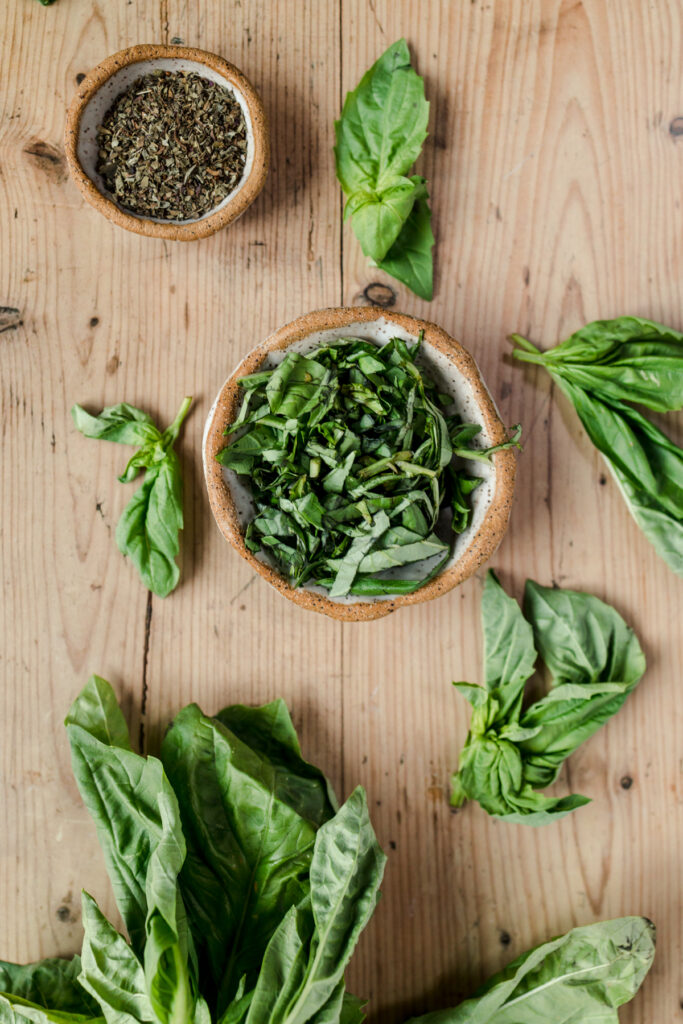
- Fresh Mint: As mentioned, basil is part of the mint family. Using a mild fresh peppermint is a good option as you may find spearmint too sweet and not peppery enough in place of basil. Dried mint is a less favorable basil substitute.
You can use fresh mint in some dishes that require basil, including Thai cooking or Mediterranean dishes. However, as you can imagine, the minty flavor is only similar to a certain degree. Therefore, you can use mint in a variety of dishes where basil is not an essential ingredient or as the perfect leafy green for garnishing.
When using mint in place of basil, start with one-fourth or half the amount as you would basil. If that’s not flavorful enough, you can always add more. - Dried Mint: Dried mint can serve as a substitute for basil, particularly in Mediterranean and Thai dishes. It offers a minty flavor, which, while distinct from basil’s profile, can still complement similar recipes. Use it in smaller quantities compared to basil, as its flavor can be quite potent and may differ significantly in certain dishes.
- Fresh Thyme: If you’re making a saucy pasta dish, thyme is a great herb to use instead of basil. It has a more earthy taste and can be a little stronger than basil due to its smaller leaves. So add in half the amount of thyme as you would basil, give it a quick taste test, and go from there.
- Dried Thyme: Dried thyme is a viable substitute for basil, especially in hearty, saucy dishes like pasta. Its earthy and somewhat stronger flavor compared to basil requires a lighter hand; starting with half the amount of thyme as you would, basil is advisable. Adjust to taste, as thyme’s potency can vary.
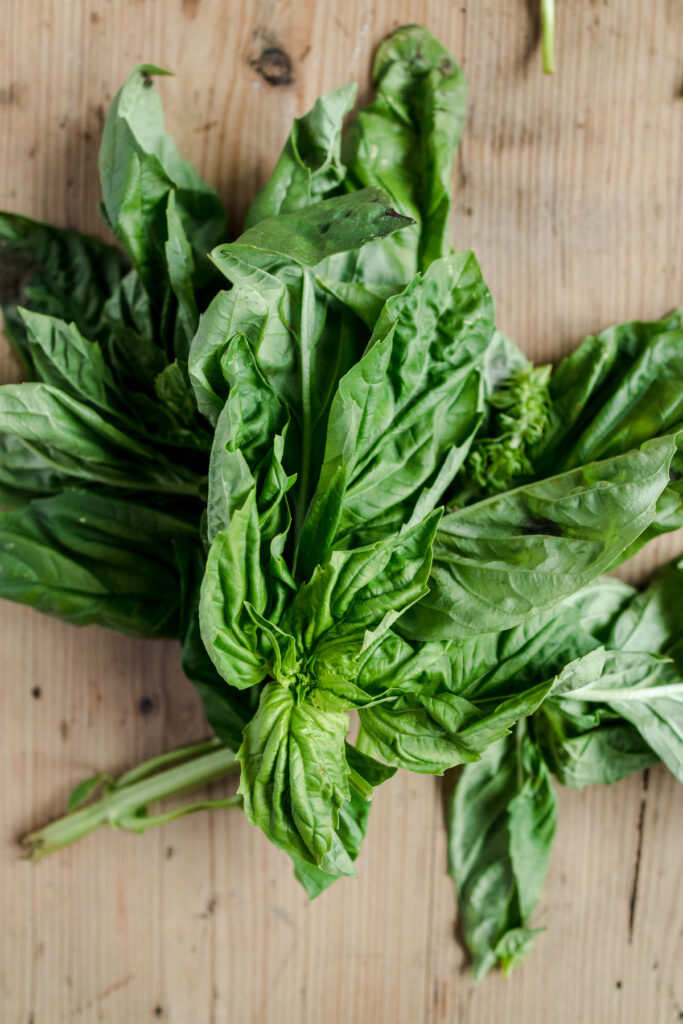
- Fresh Cilantro: Fresh cilantro can be a good alternative in several Asian, Mexican, and Latin American-inspired dishes you might be creating, such as curry, stir fry, rice, and soups. It doesn’t have a similar flavor profile to basil. However, the herbs work well in similar dishes when substituting fresh basil for fresh coriander.
- Dried Coriander: Dried coriander offers a distinct alternative to basil, especially in Asian, Mexican, and Latin American-inspired dishes such as curries, stir-fries, and soups. Although its flavor profile, with hints of citrus and earthy tones, differs from basil’s peppery and slightly sweet taste, dried coriander still complements many of the same recipes. Use it cautiously to ensure the unique flavor enhances rather than overpowers the dish.
- Herbs de Province: A blend of dried herbs typical of the Provence region in France, can be a flavorful substitute for basil in various dishes. This blend often includes thyme, basil, rosemary, tarragon, savory, marjoram, oregano, and sometimes lavender. The combination of these herbs creates a complex, aromatic profile that can mimic some of the nuances of basil, making it suitable for use in stews, grilled dishes, and roasted vegetables. The diverse flavors in Herbes de Provence make it a versatile alternative, adding depth and a touch of the Mediterranean to your cooking.
- Italian Seasoning: An Italian seasoning blend is a dried herb mixture that typically uses basil as one of its core ingredients, along with oregano, thyme, and rosemary. Therefore, most dishes can use Italian seasoning as a dried basil substitute.
- Fresh Rosemary: These dense, needle-like leaves aren’t a universal basil substitute. However, you may wish to use rosemary on any potato dish to add a pop of flavor (trust me, rosemary potatoes are in a league of their own, and once you try it, you’ll never go back!). Rosemary has a more intense flavor, particularly fresh rosemary, so go easy on this herb as a substitute for dried basil.
- Dried Rosemary: Rosemary, with its intense, aromatic flavor, is a selective substitute for basil. It’s best used in dishes where its strong pine-like and slightly lemony taste can be appreciated, such as with roasted potatoes or meats. Use it sparingly, as its flavor is much more potent than basil.
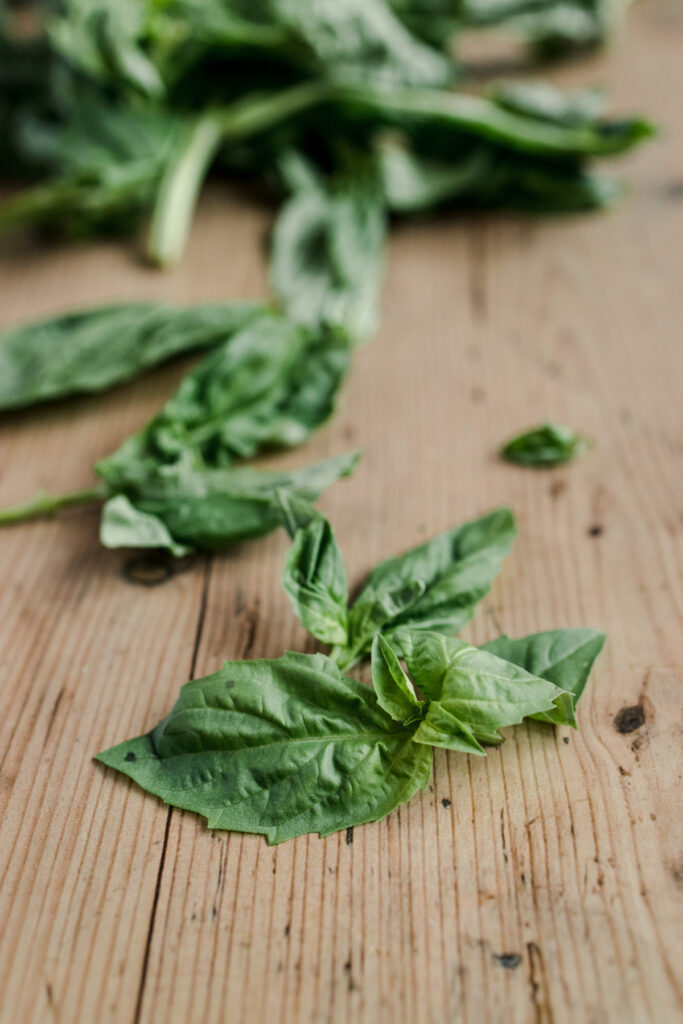
- Fresh Savory: Fresh savory offers a peppery, slightly bitter taste, making it a good basil alternative in a variety of dishes, including soups, stews, and bean recipes. Its flavor is a blend of thyme and mint, providing a unique twist to recipes that traditionally call for basil.
- Dried Savory: Dried savory maintains much of the peppery and slightly bitter taste of its fresh form, making it suitable for longer-cooked dishes where its robust flavor, similar to basil, can stand out.
- Fresh Parsley: Fresh parsley, with its bright, slightly peppery flavor, serves as an excellent garnish substitute for basil. It’s particularly good in salads, dressings, and light pasta dishes, adding a fresh, herbal note.
- Dried Parsley: While less flavorful than its fresh counterpart, dried parsley can still be used in place of dried basil for a subtle, herby addition to dishes. It works well in soups, stews, and as a seasoning for vegetables.
- Fresh Chervil: Chervil, often used in French cuisine, is a delicate herb with a flavor that’s a cross between tarragon and parsley, with subtle hints of anise. It’s a fantastic substitute for basil in lighter dishes, such as salads, soups, and egg recipes. Its mild flavor makes it versatile, and it’s particularly good in dishes where you want a hint of herbaceousness without overwhelming other flavors.
- Dried Chervil: As a dried herb, chervil retains its delicate nature, making it a suitable basil substitute in various dishes where a gentle, herby touch is desired. The flavor, reminiscent of a blend between tarragon and parsley with anise undertones, is ideal for enhancing lighter dishes like soups, dressings, and egg-based recipes. When using dried chervil, it’s important to remember that its subtlety is best appreciated in dishes that don’t require a dominant herb flavor.
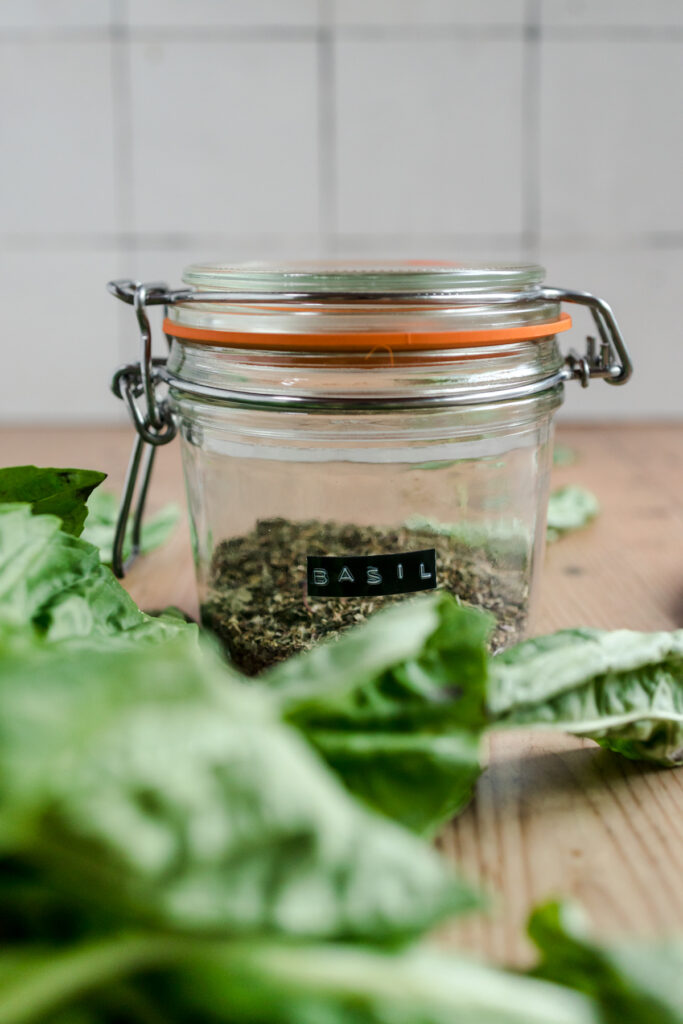
- Fresh Marjoram: This herb has a sweet, citrus, and pine flavor, which makes it a good substitute for basil, especially in Mediterranean dishes. Marjoram is softer and less intense than oregano, making it a versatile option.
- Dried Marjoram: While the dried form loses some of the citrus notes, it still serves as a decent basil substitute, particularly in slow-cooked dishes where its subtlety can be a benefit.
- Dried Parsley: You can use dried parsley instead of dry basil or their fresh counterparts in dishes that are milder in flavor. Fresh parsley also makes an excellent garnish for its mild, grassy flavor and pretty leaves.
- Carrot Tops: The leafy greens of carrots, often overlooked, can be a creative and flavorful substitute for basil. Carrot tops have a slightly bitter and earthy taste with a hint of sweetness, making them suitable for pestos, salads, and as a fresh garnish. Their unique flavor works well in dishes that benefit from a touch of herbal brightness. Using carrot tops is a great way to reduce food waste and add an unexpected twist to your recipes.
- Celery Leaf: If you are big on reducing your food waste, use leftover celery leaves or carrot tops as a substitute for fresh basil in your pesto or as an additional green in almost any salads or dips.
- Spinach: Due to their twin-like appearance, fresh spinach leaves can be a great substitute for fresh basil. Spinach doesn’t pack a punch of flavor like basil, but you can get some of the desired color and texture as the leaves are similar. Fresh spinach works especially well as a substitute in basil pesto, stir fry, or curry alongside other herbs, adding a more potent flavor.
Just a quick PSA: don’t use frozen spinach to replace fresh basil, as the texture will be off. Plus, you can’t garnish with soggy spinach (well, you could, but it won’t look good, haha).
Speaking of spinach, this Spinach Pineapple Smoothie is incredibly refreshing and healthy!
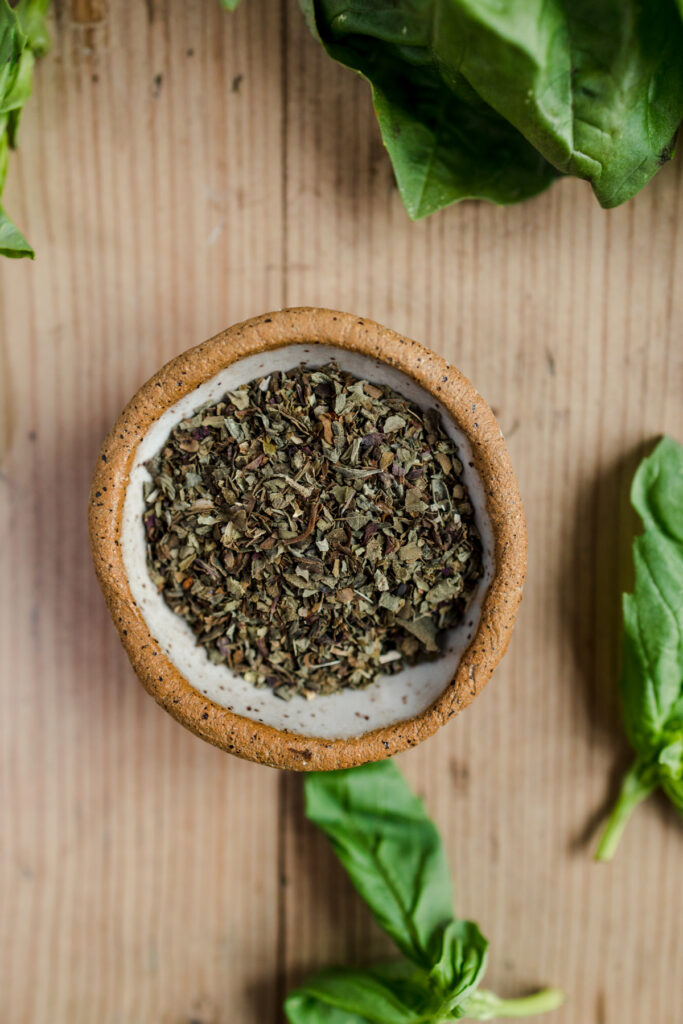
Pro Tip
Even if you are confident that an herb will work well as a substitute, put a few spoonfuls of your recipe into a bowl and add a bit of the herb to see how you like the combo before adding it to the entire batch.
FAQ
Opt for the dried form if you’re looking for a fresh basil replacement for the one you traditionally use. For the most similar herb to basil in terms of taste, try using oregano, thyme, cilantro, or mint.
Most fresh herbs and lettuce can be used for pesto. My go-to substitutions would be spinach, arugula, parsley, or carrot tops. You could always use a combination of these, too!
Along with fresh tomatoes, garlic, olive oil, and bread, basil is a crucial ingredient in bruschetta. Although fresh basil is necessary for the most authentic Italian bruschetta, you may wish to use oregano, thyme, or marjoram as the next best option.
If you have dried basil on hand, this is the best option as a fresh basil substitute. However, an alternative fresh herb is best if you are garnishing a dish.
Speaking of good garnish substitutes for basil, parsley is an excellent choice!
What does a basil plant look like?
A basil plant is characterized by its lush, vibrant green leaves, which are slightly oval with a smooth texture and pointed tips. The leaves are usually around 2 to 4 inches long, growing oppositely on a square stem, which is a common trait in the mint family to which basil belongs.
Basil plants can grow quite bushy and tall, typically reaching 1 to 2 feet in height. They sometimes produce small, white or purple flowers in a spike formation if not regularly pruned. These flowers usually emerge at the top of the stems and can add to the decorative aspect of the plant.
The overall appearance of a basil plant is quite fragrant and inviting, making it not only a culinary staple but also a popular choice for herb gardens and kitchen windowsills. The scent of basil is distinct, often described as both sweet and peppery, adding to its appeal.
Tasty Recipes With Basil
Final Words
There is no ‘perfect’ basil leaf substitute because, as with every herb, it has a unique flavor all of its own. No other culinary herb can replicate the taste of basil, so opt for dried basil in lieu of fresh when possible. However, out of all the common herbs, oregano is probably your best bet.
Each herb mentioned above will work well in recipes for different reasons. Keep taste testing along the way as you add in your herb substitute, and do a quick sniff of the herb to check that the flavor will go well with the recipe you are making.
Looking For More Helpful Substitutions?
Here are some more go-to ingredient alternatives for when you’re in a pinch!
- 25 Best Substitutes For Oregano
- 21 Best Substitutes For Turmeric
- 20 Best Substitutes Leek Substitutes
- 17 Best Vegetable Bouillon Substitutes
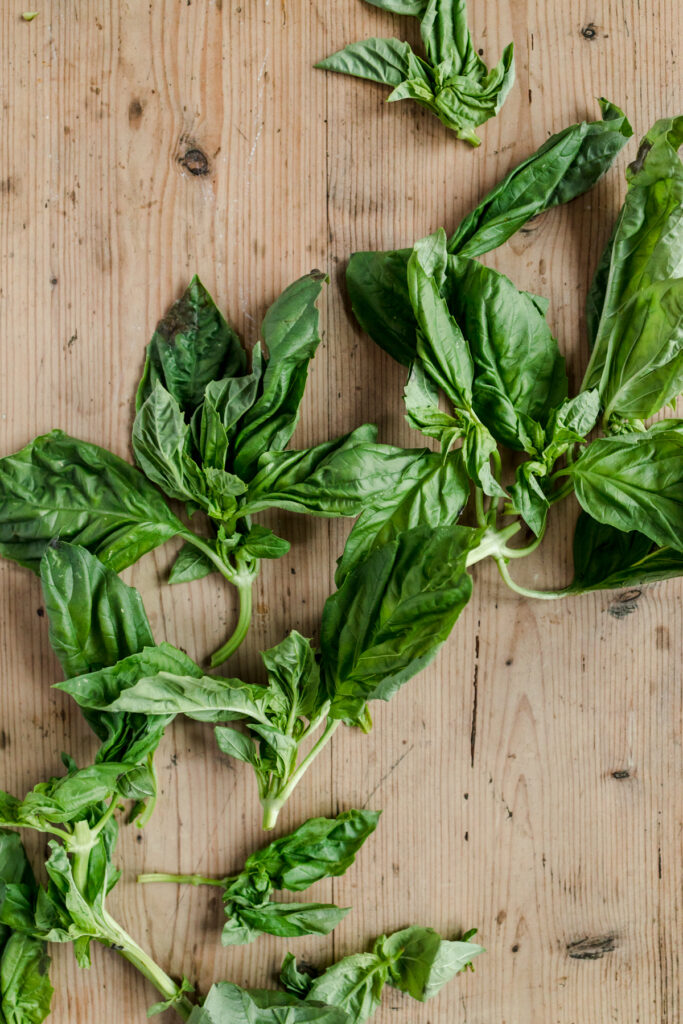
This post may contain affiliate links, meaning I’ll receive a commission if you purchase through those links at no extra cost to you. Please read our full disclosure for more information. Thank you for supporting Raepublic.

I really enjoyed this post. Obviously, nothing tastes exactly like basil, but you shared some great flavorful ideas. I like to do it to freeze my basil if I haven’t used it for a few days. This way, it won’t go to waste.